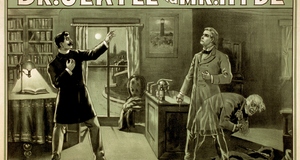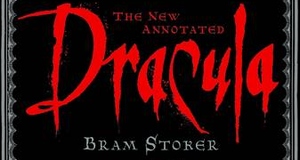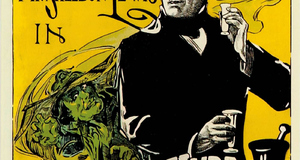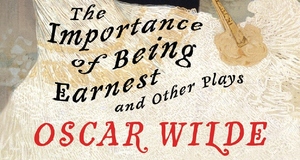Exploring the Corruption of the Soul in the Works of Oscar Wilde, Bram Stoker, and Robert Louis Stevenson
By
2015, Vol. 7 No. 04 | pg. 2/2 | « Stoker also portrays Dracula as someone who can assume many disguises in order to mask the reality of his intentions. He frequently vacillates between semblances such as a bat or a wolf. For instance, as Mina Harker, fiancée of Jonathan Harker and best friend of Lucy, looks after Lucy during the night, she notices a bat: “Between me and the moonlight flitted a great bat, coming and going in great whirling circles. Once or twice it came quite close, but was, I suppose, frightened at seeing me” (Stoker Ch. 8). Dracula assumes this form so as to appear innocent and harmless. Thus, this guise serves to veil his corrupting, violent nature. Interestingly, Dracula is successful in this regard, as Mina remains oblivious to the fact that the bat is Dracula. His looks, once again, belie reality, as his true intentions – among others, his thirst for blood – stay imperceptible at this time. By the same token, Stoker provides another example of Dracula’s physical disguise as a bat prior to when the wolf jumps through the window. Lucy observes “a big bat, which was flapping its silent and ghostly way to the west” (Stoker Ch. 9). This veneer is only one of many forms Dracula assumes throughout the novel so as to deceive. Dracula also transforms into a wolf and terrorizes Lucy and her mother, ultimately murdering the latter, as Lucy later states, “They lifted off the body of my dear mother, and laid her, covered up with a sheet, on the bed after I had got up” (Stoker Ch. 11). Lucy describes her reaction to the ensuing chaos that erupts owing to the wolf’s violence: “The room and all round seemed to spin round. I kept my eyes fixed on the window, but the wolf drew his head back, and a whole myriad of little specks seemed to come blowing in through the broken window” (Stoker Ch. 11). This recurring form of disguise underscores the ways in which corruption can be concealed in society, as Dracula shape-shifts and dons various appearances in order to keep his identity hidden.Dracula continues to modify his appearance, as he can quite adeptly alternate between human and amorphous vapour form. Dracula specifically demonstrates this ability after Harker walks in as Dracula forces Mina to feed upon him like “a child forcing a kitten’s nose into a saucer of milk to compel it to drink” (Stoker Ch. 21). Harker reacts by lifting his crucifix, thereby frightening Dracula, who proceeds to escape by transforming into intangible water vapor and disappearing under the door. Dr. Seward notes in his diary this visible alteration, as he states, “The moonlight suddenly failed, as a great black cloud sailed across the sky; and when the gaslight sprang up under Quincey’s match, we saw nothing but a faint vapour” (Stoker Ch. 21). In this scenario, Dracula uses vapor as a means of escape. Furthermore, Dracula physically embodies the theme of appearance versus reality, as his looks and outward behavior contradict his underlying motives that lurk beneath the surface. As the novel progresses, Stoker continues to expose Dracula’s sinister nature, as the Count behaves brutally towards characters such as Mina Harker. Stoker reveals the underbelly of Dracula’s character, as Dracula is depicted as not only feeding upon Mina, but also forcing her to drink his blood. Dr. Seward recounts the interaction in his diary, stating that Dracula’s “right hand gripped her by the back of the neck, forcing her face down on his bosom” (Stoker Ch. 21). This act of physical aggression illustrates Dracula’s brutality and his simultaneous desire to corrupt her by turning her into a vampire and, in so doing, make her less human. Accordingly, despite prior gentility and civility suggested by his polite appearance at the beginning of the novel, Dracula can now be sufficiently characterized as inherently evil. Seward also comments on the Count’s monstrous facial expressions: “the Count turned his face, and the hellish look that I had heard described seemed to leap into it. His eyes flamed red with devilish passion” (Stoker Ch. 21). Stoker’s use of the word “passion” can only imply that Dracula revels in this inhuman and debauched activities. Dracula’s countenance amid this frenzy serves to buttress the notion that corruption can permeate society when appearances deceive reality. Stoker also draws on the concept of age in order to raise the theme of appearance versus reality. With regard to Dracula’s appearance, the greater the strength he possesses, the more youthful he looks. For instance, towards the beginning of the novel, upon first meeting Dracula, Harker comments on the count’s exterior: “Within, stood a tall old man, clean shaven save for a long white moustache” (Stoker Ch. 2). As indicated by the white color of his hair and Stoker’s explicit use of the word “old,” Dracula is portrayed as anything but youthful. However, later on in the novel, when Dracula increasingly indulges in his blood-sucking tendencies, his appearance seems to defy the clock and even travel back in time, as he now possesses a “black moustache and pointed beard” (Stoker Ch. 13). This shift in appearance smacks of incongruity so much that Harker even exclaims to himself, “I believe it is the Count, but he has grown young. My God, if this be so!” (Stoker Ch. 13). This supernatural occurrence emphasizes the distinction between looks and reality, as Dracula’s age is concealed by his fluctuating blood-sucking propensities. Thus, once again, this contrast enables readers to examine how corruption can play such an integral role in concealing reality. In Robert Louis Stevenson’s Strange Case of Dr. Jekyll and Mr. Hyde, the author shows that the appearance of Dr. Henry Jekyll, a respected doctor, belies his evil actions. For instance, Dr. Jekyll resides in a house that is considered to have “a great air of wealth and comfort” (Stevenson 12), and he appears to be a well-respected and admired man, particularly given the fact that he hosts grand events such as “one of his pleasant dinners to some five or six old cronies, all intelligent, reputable men and all judges of good wine” (Stevenson 15). Even so, however, his distasteful penchant for pleasure ultimately manifests itself. Towards the end of the novel, Mr. Utterson, Dr. Jekyll’s lawyer, reads Jekyll’s letter, which reveals Jekyll to be a murderer: “Instantly the spirit of hell awoke in me and raged. With a transport of glee, I mauled the unresisting body, tasting delight from every blow” (Stevenson 58). As evidenced by this monstrous violence, Jekyll’s lust for experiencing pleasure and crime without any strings attached translates into physical expression in the form of Mr. Hyde. Accordingly, Mr. Hyde serves not only as a vehicle for Jekyll to succumb to his own illicit appetites, but also as a means for hiding the reality of Jekyll’s inner desires. Moreover, the theme of looks versus truth allows readers to explore how individuals mask corruption in an effort to preserve their reputations. In some cases there exists a clearly demarcated line between appearance and reality in this novel, as Dr. Jekyll hides his dual personality, Mr. Hyde, in an attempt to preserve his own esteemed reputation in society. For instance, Dr. Jekyll decides to give to Utterson a letter he received from Hyde rather than turning it in to the police; in this case, he acts out of fear of detection and ultimately tarnishing his social standing (Stevenson 22). Nevertheless, despite these efforts, Jekyll eventually discloses his own corrupt tendencies, as he confesses about his evil side: “‘Even as good shone upon the countenance of the one, evil was written broadly and plainly on the face of the other’” (Stevenson 52). This declaration suggests that no crime goes unnoticed in society and corruption seldom remains forever hidden. Interestingly, Mr. Enfield, an old friend of Mr. Utterson, surmises correctly about Mr. Hyde’s nature based on the latter’s appearance, specifically when stating that “There is something wrong with his appearance; something displeasing, something downright detestable. I never saw a man I so disliked, and yet I scarce know why. He must be deformed somewhere; he gives a strong feeling of deformity, although I couldn't specify the point” (Stevenson 5). As evidenced by the text, Mr. Enfield clearly suspects Mr. Hyde of some strange, wicked secret. This example highlights the correlation between appearance and reality in determining one’s character because, on the basis of appearance, Mr. Enfield deduces that Hyde is a morally despicable, iniquitous human being with twisted intentions. Of note, Mr. Enfield’s conjecture proves to be accurate, as Mr. Hyde is revealed to be the “the murderer of Carew” (Stevenson 48), a client of Utterson who was found “incredibly mangled” in a lane gutter (Stevenson 18). Consequently, this example depicts how looks can variably correspond to inner corruption. In addition, despite Hyde’s attempt to avoid attention and appear inconspicuous and “perfectly cool” (Stevenson 3), his debauched nature, which is shrouded by his exterior, is immediately noticed by Mr. Enfield. This triumph of Hyde’s true evil nature over a carefully architected façade may also demonstrate the fallibility of corruption in society. Whereas Dr. Jekyll’s appearance implies that he is a morally intact, gentle and honorable man, Mr. Hyde’s personality conveys a part of Jekyll’s nature that, until Jekyll takes the potion, has remained concealed within his soul. Towards the end of the novel, Jekyll even notes in his letter: “My devil had been long caged, he came out roaring” (Stevenson 57). This statement shows that the hidden reality of Jekyll’s inner desires ultimately surface in the tangible form of Mr. Hyde. Jekyll’s desire to concede to sinful pleasures symbolizes part of his true nature. Through this account, Jekyll’s ruthless and evil side is ultimately exposed, thereby evincing the reality of his inner mind. Remarkably, this piece of reality lies dormant for most of the novel, in so doing, revealing the ability of an individual to hide internal corruption. Moreover, Oscar Wilde’s The Picture of Dorian Gray, Bram Stoker’s Dracula, and Robert Louis Stevenson’s Strange Case of Dr. Jekyll and Mr. Hyde, allow readers to explore corruption by raising the theme of appearance versus reality. The Picture of Dorian Gray portrays a physical representation of the distinction between one’s exterior versus interior. In Dracula, readers also encounter a similar discrepancy owing to the observed clash between Count Dracula’s looks and true intentions. Likewise, the Strange Case of Dr. Jekyll and Mr. Hyde draws upon this theme in order to show how corruption can be hidden in society. In essence, the theme of appearance versus reality is vividly conveyed in each work in order to ultimately explore the concept of corruption in individuals and, on a larger scale, society. ReferencesStevenson, R. L. (1895). Strange Case of Dr. Jekyll and Mr. Hyde (Vol. 7). Scribner. Stoker, B. (2007). Dracula. Penguin. Wilde, O. (1891). The Picture of Dorian Gray. Penguin. Endnotes
Suggested Reading from Inquiries Journal
Inquiries Journal provides undergraduate and graduate students around the world a platform for the wide dissemination of academic work over a range of core disciplines. Representing the work of students from hundreds of institutions around the globe, Inquiries Journal's large database of academic articles is completely free. Learn more | Blog | Submit Latest in Literature |


















